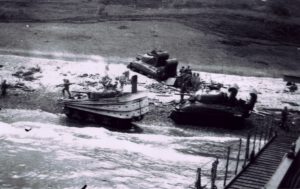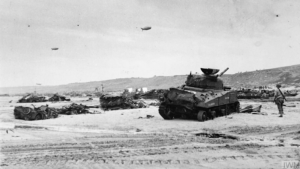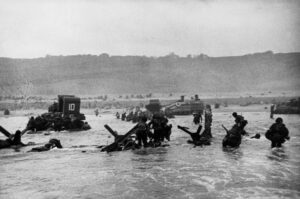Did all the American amphibious tanks really sink at Omaha Beach?
The false legends of D-Day
Photo: US National Archives
The false legend of D-Day: ‘All the American tanks sank in the Channel’.
‘We have no DD [Duplex Drive] tanks on the beach’. This was the message that Captain John H. Miller wanted to transmit by radio on Omaha beach on the morning of 6 June 1944. This sentence was spoken by the actor Tom Hanks in the film Saving Private Ryan, playing a fictional character from the provisional US Ranger group. It sums up the legend of the amphibious tanks, whose fate is often associated with the very high casualty rate on this beach on D-Day.
The theory that no American amphibious tank managed to reach Omaha beach on D-Day is still widely held. In fact, on 6 June 1944, several dozen tanks, including the Sherman ‘Duplex Drive’ (also known as the ‘Donald Duck’), were able to reach the shore, helping to neutralise some of the German defences. These tanks, consisting of a floating skirt and a propeller, had to be launched less than six kilometres from the beach before reaching their respective sectors by their own means.

Photo: US National Archives
- The assault plan for the 97 American amphibious tanks planned for the landing on Omaha Beach before the arrival of the first wave of infantrymen.
Let’s take a closer look at what really happened on D-Day at Omaha Beach. The assault plan of the 1st Infantry Division (the American unit responsible for seizing the bridgehead in this sector, which also had formations of the 29th Infantry Division under its command) called for two tank regiments to take part in the offensive in the early hours of this engagement: the 741st Tank Battalion (TB) and the 743rd TB, with 64 Duplex Drive tanks in particular.
More specifically, to the west of Omaha Beach opposite Vierville-sur-Mer, the 743rd TB was to deploy 32 Duplex Drive tanks from Companies B and C aboard barges from LCT Group 35. To the east of the beach, opposite Saint-Laurent-sur-Mer and Colleville-sur-Mer, the 741st TB was to launch 32 amphibious tanks (16 from Company B of the 741st Tank Battalion (TB) to the eastern part of Easy Red and 16 from Company C of the 741st TB to Fox Red).
According to the meticulous planning of the landing plan, these amphibious armoured vehicles were scheduled to reach the beach 11 minutes before the first infantrymen (i.e. 6.20 am), remaining partially in the water to both engage the enemy strongpoints and cover the arrival of the landing craft.
At 6.30 am, exactly one minute before the theoretical arrival of the first assault wave, ten Shermans and five Sherman bulldozers from A Company, 741st TB, as well as 12 Shermans and six Sherman bulldozers from A Company, 743rd TB, had to be landed directly on the beach by armoured LCT (Landing Craft Tank) barges (LCT-A, A for Armored) in order to increase the attackers’ firepower while opening up routes through the obstacles. In all, no fewer than 97 armoured vehicles are scheduled to take part in the assault before the first soldiers arrive on the beach: 64 amphibious tanks, 22 Shermans and 11 Sherman Bulldozers.
LCT(A) (Landing Craft Tank – Armor) 2273 loaded with three M4 Shermans in front of Omaha Beach on 6 June 1944.
Photo: US National Archives
- Deployment of American amphibious tanks on D-Day.
Situation of the 743rd TB off Vierville-sur-Mer: successful adaptation.
On 6 June 1944 at 5am, when the barges carrying the American amphibious tanks reached the launching zone, the swell was far too strong for the special craft (the westerly wind and current created waves up to two metres high). What’s more, the launch seems to be far too far from the coast. In line with the non-compliant cases studied during the preparation of this mission, the confirmation of the launch on the high seas was the responsibility of the most experienced officer in the unit. Captain Ned S. Elder, commanding ‘C’ Company, 743rd TB, gave the order to land the armoured vehicles of ‘B’ and ‘C’ Companies directly on the beach, preferring to risk exposing the LCT barges, which had not been over-armoured, unlike the LCT(A) barges carrying ‘A’ Company.
At 6.30 am, on schedule but not exactly where planned, six LCTs unloaded the 12 Shermans and six Sherman Bulldozers from A Company all over the beach. They were supposed to reinforce the amphibious tanks of companies B and C, but these were not yet present, as a result of the decision to land them directly on the beach and navigation delays.
From 6.40 am, the first tanks from B and C companies of the 743rd TB finally reached the beach, the LCTs having managed to clear a path between the obstacles and the other barges carrying the infantry. The LCT carrying Captain Charles W. Ehmka, unit commander of B Company, was hit by shells: four officers were killed, including Ehmka.
By 7.45 am, more than 40 Shermans of the 743rd TB were operational opposite Vierville-sur-Mer, between the Charlie and Dog Red sectors. Most of the tanks remained under cover in the dark waters of the English Channel, with only the upper half of the body protruding from the waves. They moved with the tide.
An M4 Sherman tank abandoned on Omaha beach after the fighting.
Photo: IWM
Situation of the 741st TB off Saint-Laurent-sur-Mer and Colleville-sur-Mer: the failure of the ‘DDs’.
Conversely, for the 741st TB, the launch was confirmed by the two unit commanders concerned, Captain James G. Thornton Jr (Company B) and Captain Charles R. Young (Company C).
At 5.40am, the sailors of LCT Group 35 hoisted the yellow pennants signifying the start of the launching manoeuvre: the first Duplex Drive tanks went down the ramp and left the LCTs, but they sank in the Channel, the floating skirts being quickly submerged by the heavy swell (sometimes after about ten minutes of crossing).
The 16 amphibious tanks of C Company entered the sea. All of them, without exception, sank in the Channel. Although most of the crews managed to be saved, several of the fighters drowned.
Observing the disastrous fate of the first tank launched into the sea from the LCT-600, Ensign Henry P. Sullyvan decided, in agreement with the section leader, 2nd Lieutenant Patrick J. O’Shaughnessy, to stop launching the next three tanks. As a result, only 13 of the 16 Sherman Duplex Drives of Company B, 741st TB, were launched off Omaha.
At 6.30 am, in the Dog Green sector, the first LCT carrying two M4 Shermans and a Sherman bulldozer tank from A Company, 741st TB, reached the beach: it landed the first armoured vehicles facing Saint-Laurent-sur-Mer. They immediately went into battle, half hidden in the sea at wave height. This small detachment was commanded by Staff Sergeant Walter J. Skiba.
Two minutes later, at 6:32 am, the three Duplex Drives still aboard the LCT-600 also disembarked. Moments later, two of the 13 Sherman Duplex Drives from Company B launched at sea reached land on Easy Red. These five tanks were the only survivors from Companies B and C of the 741st TB, the regiment having lost 60% of its combat potential before it could even engage in combat.
Two LCTs carrying part of A Company of 741st TB and destined for the eastern part of Easy Red sank during the approach phase due to uncontrollable waterways. Three other barges reached the beach late, after the infantrymen had arrived. These tanks were immediately attacked by German guns, most of which managed to neutralise them.
Of the 29 Duplex Drives of the 741st TB launched on 6 June 1944, 27 sank before reaching the beach. The only two amphibious tanks from this regiment to make the crossing were commanded by Sergeant George Geddes and Sergeant Turner Sheppard.
By the evening of 6 June 1944, the 741st TB had lost 48 tanks. 45 of its men were killed and 60 wounded.
American forces landing on Omaha Beach on 6 June 1944 in the Easy Red sector opposite Saint-Laurent-sur-Mer. Two DD tanks of the 741st Tank Battalion can be identified by their raised skirts. The other tanks were fitted with the Schnorkel exhaust system.
Photo: Robert Capa/Magnum.
Conlusion of the American armoured landing at Omaha Beach.
Of the 29 American amphibious tanks actually launched on 6 June 1944 off Omaha Beach (instead of the 64 planned), 27 actually sank in the Channel (all belonging to the 741st TB). But can it really be said that there were no tanks in the area on D-Day to support the infantry?
No, because other tanks managed to reach the mainland, either because they managed to cross under their own steam (in the case of only two of them), or because they were landed directly on the beach, like the tanks of the 743rd TB.
Although the weather conditions proved disastrous for the concept of using amphibious tanks at Omaha Beach, they did not prevent tanks from landing on the beach, a fact that is often underestimated. Indeed, 58 tanks reached this sector on D-Day: by 7am, 14 had already been destroyed or abandoned. The others were blocked on the beach by the anti-tank wall or were skating on the pebbles waiting for the first inland breakthroughs.
Lacking firepower and without the support of other special armoured vehicles (like the whole range of ‘funnies’ deployed by the British forces), the infantrymen were unable to silence the German defensive positions within the allotted time and suffered heavy losses as a result, lacking firepower considerably.
Marc Laurenceau
Sources and bibliography:
741st Tank Battalion After Action Report, 1944.
743rd Tank Battalion After Action Report, 1944.
LAURENCEAU Marc, Historial du Jour J et de la bataille de Normandie, 6 juin – 25 août, OREP, 2024.




